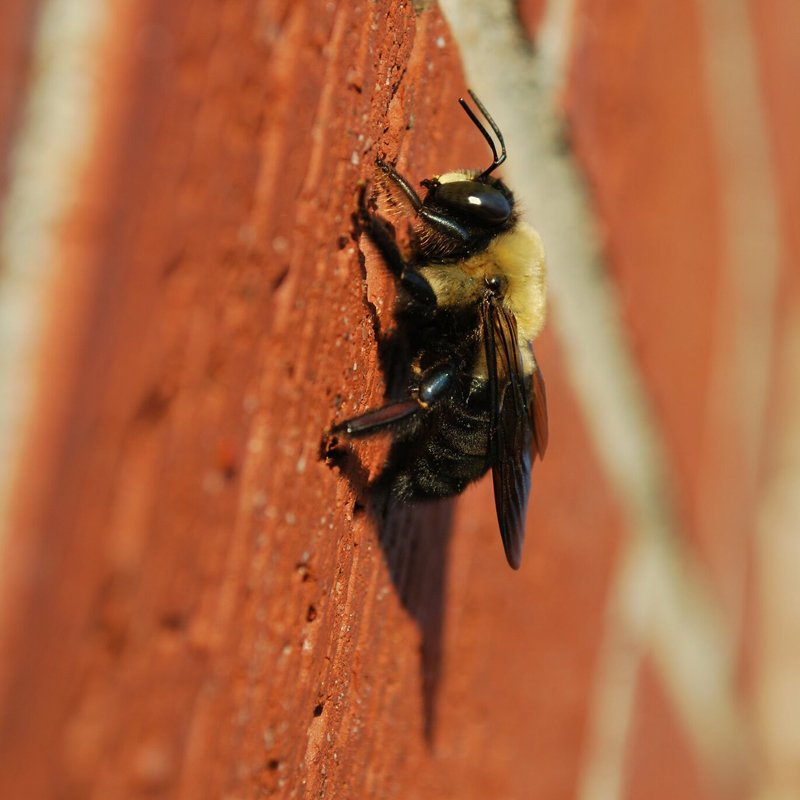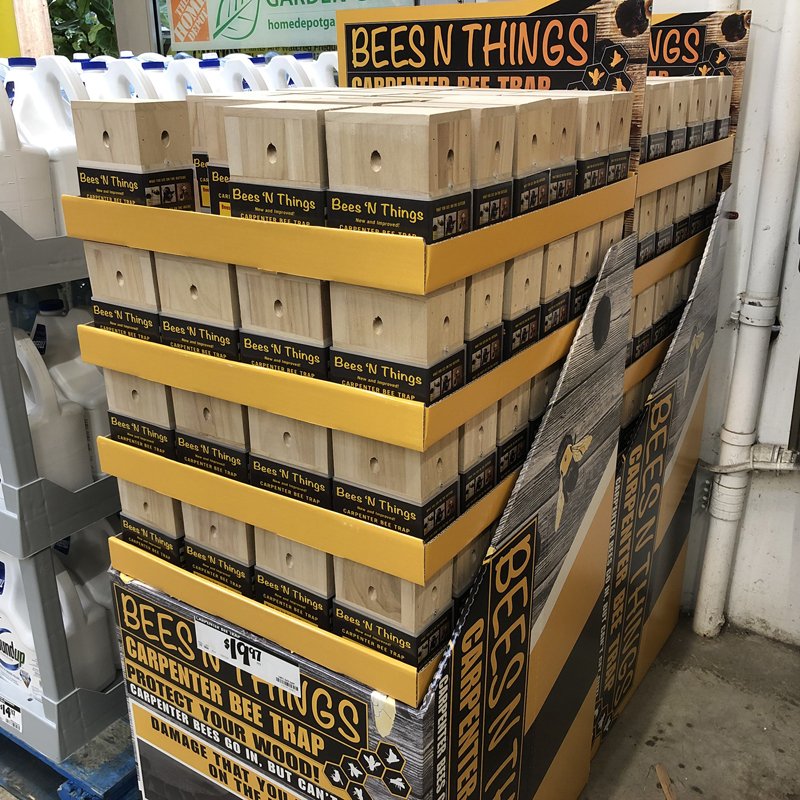They’re Back!
Warm weather brings a tremendously destructive and determined pest to our homes: carpenter bees. The damage they start is often compounded by other forces. Protect your property with these simple steps…
Xylocopa Virginica (Eastern Carpenter Bee). Image by Chris Faulkner
It’s truly ironic that these pests are called carpenter bees since they don’t build anything. Instead, they cause damage by chewing their way into the wood on our homes to lay eggs that will hatch into more carpenter bees… who would like nothing more than to perpetuate the cycle by making more nests and more bees.
Why Do They Bore Holes in Our Homes?
There are about 500 species of carpenter bees. They’re sometimes called wood bees because they bore into wood. They don’t eat the wood, they chew the wood to create openings that they use to nest. Like other bees, carpenter bees are pollinators. They eat nectar from flowers.
Carpenter bee chewing its nest. Image by Helena Jacoba.
Female carpenter bees bore holes in wood that range from four inches in depth to many feet. They lay their eggs in galleries – they lay one egg and bring in pollen to feed the larvae when it hatches. They seal the egg and pollen into a small chamber in the hole they’ve bored and repeat the process so a single carpenter bee hole may be filled with many chambers.
Prevention is the Best Option
Carpenter bees prefer to bore into unfinished wood. They look for cracks and other natural protection for their nests. They often bore into the underside of wood trim and decks. You can discourage them from boring into your wood by varnishing or painting the wood. Painting has the most significant effect.
This is particularly important on the underside of exterior wood decks. It’s relatively easy to varnish or seal the top of wood deck components though it takes more work and attention to detail to varnish or seal the underside and ends of components.
Compounding and Costly Damage
The damage from carpenter bee nests can be compounded by their predators and natural forces. In the image below, a woodpecker pecked open the carpenter bee nests to eat the bees. The damage from the woodpecker causes further damage to the structure and makes it easier for water to collect in the openings.
Carpenter bee nests opened by a woodpecker. Image by Isaac Wedin.
It’s bothersome for carpenter bees to damage trim and other non-structural elements on a home. It’s dangerous for them to damage structural components like the joists and beams of an exterior deck. It’s difficult (and costly) to replace structural components on exterior decks because they’re connected to so many other parts of the deck.
In the image below, the beam along the outside of the deck is two 2x10 pieces of lumber. You can see the bottom of the pickets of the deck railing screwed into the outer 2x10.
Carpenter bee nests rotted by water damage.
Water damage has opened the carpenter bee nests (no woodpecker needed) and caused rot all the way through the outer 2x10. The floor of the deck and the deck railing are no longer able to carry the weight for which they were designed. An occupant risks collapse or a fall from failure of the railing.
The scary part about this sort of damage is you can’t see it from above - it can’t be seen by someone stepping from the house out onto the deck. You wouldn’t know how compromised the deck is unless you made an inspection first.
This damage necessitates premature replacement of the structure. In the case above, the entire railing will have to be replaced. Replacement of an exterior wood deck can easily be a five-figure expense so it’s important to protect your investment by having it designed to shed water and taking steps to prevent carpenter bee damage.
Act Early and Use Multiple Deterrents
Varnishing or painting your exterior wood can discourage carpenter bees from boring nests into your wood. If you’re still having problems, you can try to trap the carpenter bees.
Example of a wood bee trap you can buy.
Carpenter bee traps are typically a wood box with holes in it and a mason jar at the bottom. Carpenter bees enter the wood box to inspect it so they can determine if it’s a suitable place to lay eggs. When they determine it is not, they try to leave by flying toward the light of the mason jar where they become trapped.
You can also try to prevent carpenter bee damage with an appropriate dust, aerosol or liquid insecticide to kill the bees. Insecticides should be residual – designed to work as a lasting deterrent.
We’ve already mentioned wood peckers eating carpenter bees. Mocking birds also eat adult carpenter bees.
You might have a wood pecker that occasionally pecks on your house - they make a huge racket when they peck on metal components like gutters and flashing. Even if you’d like to see an irritating wood pecker gone too, try to avoid using an insecticide unless you feel you have to in order to protect your home. We prefer starting with traps because the insecticide may also kill birds which consume the carpenter bees.
It’s critical that you act early to prevent carpenter bees from removing any significant amount of wood. Letting them work can mean you’ll see less of them and assume they’ve gone away. In reality, they’re spending more time making their nest holes deeper in your home.
Addressing Damaged Wood
You should close the damage caused by carpenter bees when the damage is not significant - not enough to weaken a structure. You’ll need to consider replacement rather than repair if the damage is significant. Let a professional make that determination if you’re not sure.
Close the damage only when the wood is dry - there’s no trapped water. Wood on the outside of our homes expands and contracts constantly due to changes in temperature and humidity.
Try to use a cork, wood putty or other similar material that will expand and contract with the wood you’re plugging. Carpenter bee season ends in the fall as the weather gets colder so that’s the best time to seal the holes.
Stay Off that Ladder!
Carpenter bees often nest in challenging locations. It’s difficult for us to reach wood that’s far off the ground to varnish or paint it frequently and it’s these pieces of unprotected wood that carpenter bees attack first. If you notice that you’ve got carpenter bees nesting or trying to nest in wood on the outside of your house, consider calling your pest control company.
The bees are probably covered by your pest control contract and your pest control professional can get on a ladder (rather than you) to do battle with the bees. You may need to hire a professional to repair damage caused by the bees though you can leave the ladder climbing to them too.
Remain on Guard
Carpenter bees prefer to re-use the same nest each year. If you kill as many bees and eggs as possible yet a few survive, they will likely return to the same area and may try to bore a new nest within a few inches of the old nest. It’s important to monitor areas of previous activity to stop new damage as quickly as possible.
In Conclusion
If you don’t want carpenter bees chewing up your home or you need to repair existing damage, you can consider using synthetic materials rather than wood. You’ll need to be deliberate in your decisions since not all synthetic materials are ideal for all conditions.
Replacing wood trim with cement fiberboard products may reduce your carpenter bee woes and give you a more durable exterior that requires less maintenance such as painting. Your architect should be able to present other options to make the exterior of your home more durable so you can spend your time and money on other issues.
Our Attempt to Brighten Your Day
Some of our blog topics are too serious for jokes. We’ve asked you to think about structural damage caused by a flying bug in this blog topic so here’s our attempt to brighten your outlook before you leave…
What kind of bee speaks too quietly?
A mumble bee.
What’s a bee’s favorite sport?
Rugbee
What’s a bee’s favorite novel?
The Great Gatsbee
Who is a bee’s favorite entertainer?
Beeyonce
What kind of bee drops things?
A fumble bee.
What’s a bee’s favorite hair style?
A buzz cut.
What’s a bee’s favorite flower?
Beegonias
Who is a bee’s favorite painter?
Pablo Beecasso
We’ll spare you the dozens more puns and jokes and close by wishing you a beeutiful day!
COMMENTS: We’ve enabled comments for this post to encourage discussion and learn from you. Please review and adhere to the blog comment policy in our Terms of Service if you want your comment to be posted. Requirements include no anonymous posts (first name and last initial is fine). Please include your email address - your email address will not be displayed or added to our email list. All comments are moderated - they will not appear immediately.




